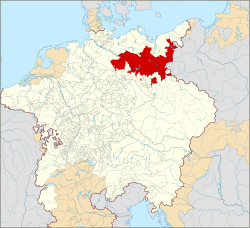March/Margraviate of Brandenburg Mark/Markgrafschaft Brandenburg (German) | |||||||||||||||
|---|---|---|---|---|---|---|---|---|---|---|---|---|---|---|---|
| 1157–1815 | |||||||||||||||
Top: Flag or naval ensign c. 1684 (based on L. Verschuier's painting[2])
Bottom: Flag 1660–1750 used by Hohenzollerns | |||||||||||||||
 Margraviate of Brandenburg within the Holy Roman Empire (1618) | |||||||||||||||
| Status | State of the Holy Roman Empire Imperial elector (1356–1806) Crown land of the Bohemian Crown (1373–1415) | ||||||||||||||
| Capital | Brandenburg an der Havel (1157–1417) Berlin (1417–1815) | ||||||||||||||
| Common languages | |||||||||||||||
| Religion | Dominant confession among the population was Roman Catholic until the 1530s, then Lutheran. Elector was Roman Catholic until 1539, then Lutheran until 1613, and then Reformed. | ||||||||||||||
| Government | Monarchy | ||||||||||||||
| Margrave | |||||||||||||||
• 1157–1170 | Albert the Bear (first) 1417 | ||||||||||||||
• 1797–1815 | Frederick William III (last) | ||||||||||||||
| History | |||||||||||||||
• Established | 3 October 1157 | ||||||||||||||
• Raised to Electorate | 25 December 1356 | ||||||||||||||
| 27 August 1618 | |||||||||||||||
| 18 January 1701 | |||||||||||||||
• Dissolution of the Holy Roman Empire | 6 August 1815 | ||||||||||||||
| |||||||||||||||
| Today part of | |||||||||||||||
The Margraviate of Brandenburg (German: Markgrafschaft Brandenburg) was a major principality of the Holy Roman Empire from 1157 to 1815 that, having electoral status although being quite poor, grew rapidly in importance after inheriting the Duchy of Prussia in 1618 and then came to play a pivotal role in the history of Germany and that of Central Europe as core of the Prussian kingdom.
Brandenburg developed out of the Northern March founded in the territory of the Slavic Wends. It derived one of its names from this inheritance, the March of Brandenburg (Mark Brandenburg). Its ruling margraves were established as prestigious prince-electors in the Golden Bull of 1356, allowing them to vote in the election of the Holy Roman Emperor. The state thus became additionally known as Electoral Brandenburg or the Electorate of Brandenburg (Kurbrandenburg or Kurfürstentum Brandenburg).
The House of Hohenzollern came to the throne of Brandenburg in 1415. In 1417, Frederick I moved its capital from Brandenburg an der Havel to Berlin. By 1535, the electorate had an area of some 10,000 square miles (26,000 km2) and a population of 400,000.[3] Under Hohenzollern leadership, Brandenburg grew rapidly in power during the 17th century and inherited the Duchy of Prussia. The resulting Brandenburg-Prussia was the predecessor of the Kingdom of Prussia, which became a leading German state during the 18th century. Although the electors' highest title was "King in/of Prussia", their power base remained in Brandenburg and its capital Berlin.
The Margraviate of Brandenburg ended with the dissolution of the Holy Roman Empire in 1806. It was replaced after the Napoleonic Wars with the Prussian Province of Brandenburg in 1815. The Hohenzollern Kingdom of Prussia was the primary driving force behind the unification of Germany. The Prussian-dominated North German Confederation later transformed in 1871 into the German Empire; it was the legal predecessor of the united German Reich of 1871–1945, and as such a direct ancestor of the present-day Federal Republic of Germany,
- ^ Based on some original preserved depictions:
-
Berlin Bear with Brandenburg coat of arms, late 18th / Early 19th Century; Märkisches Museum Berlin
-
Ceiling painting (detail: female allegory with wreath of grain ears and the Brandenburg eagle), oil on canvas, 1751 (destroyed in World War II)
-
Museum Senftenberg (Senftenberg Castle)
-
- ^ Die kurbrandenburgische Flotte (1684)
- ^ Preserved Smith. The Social Background of the Reformation. 1920. Page 17.


![Coat of arms as Electorate[1] of Brandenburg](http://upload.wikimedia.org/wikipedia/commons/thumb/b/b2/Arms_of_Brandenburg.svg/85px-Arms_of_Brandenburg.svg.png)


